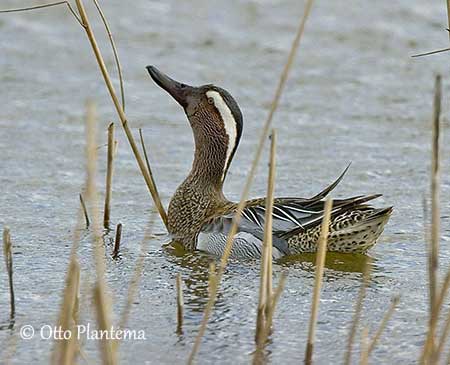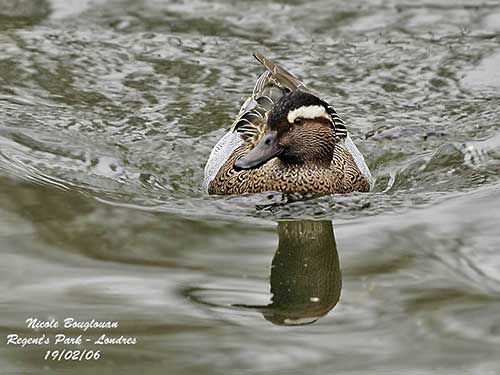
Fr : Sarcelle d’été
Ang : Garganey
All : Knäkente
Esp : Cerceta Carretona
Ita : Marzaiola
Nd : Zomertaling
Sd : årta
Photographers :
Didier Buysse
Vision d’Oiseaux
Steve Garvie
RAINBIRDER Photo galleries & Flickr Rainbirder
Jean-Claude Jamoulle
A la rencontre des Oiseaux
Otto Plantema
Trips around the world
Jean Marc Rabby
Des Ailes et des Plumes
Ingo Waschkies
Bird Photography
Nicole Bouglouan
Photographic ramble & My pictures on IBC
Text by Nicole Bouglouan
Sources :
HANDBOOK OF THE BIRDS OF THE WORLD vol 1 by Josep del Hoyo-Andrew Elliot-Jordi Sargatal - Lynx Edicions - ISBN: 8487334105
THE COMPLETE BOOK OF BRITISH BIRDS – Written by “Royal Society for the Protection of Birds” experts - Préface de Magnus Magnusson - Michael Cady- Rob Hume Editors - ISBN: 0749509112
THE HANDBOOK OF BIRD IDENTIFICATION FOR EUROPE AND THE WESTERN PALEARCTIC by Mark Beaman, Steve Madge - C. Helm - ISBN: 0713639601
GUIDE DES CANARDS, DES OIES ET DES CYGNES – de Steve Madge - Delachaux et Niestlé - ISBN: 2603013769
ENCYCLOPEDIE DES OISEAUX DE FRANCE ET D’EUROPE – de Peter Hayman et Rob Hume - Flammarion – ISBN : 2082009920
A Field Guide to the Birds of South-East Asia by Craig Robson. New Holland Publishers. ISBN: 9781780090498
BIRDS OF AFRICA SOUTH OF THE SAHARA by Ian Sinclair and Peter Ryan - Princeton University Press Princeton and Oxford - ISBN: 0691118159
LES OISEAUX D’EUROPE ET D’AFRIQUE DU NORD par Hermann Heinzel, Richard Fitter, John Parslow - Delachaux Niestlé - Isbn : 2603014862
Bird Words - The official site of Dominic Couzens, natural history writer
What Bird-The ultimate Bird Guide (Mitchell Waite)
Bird Web (Seattle Audubon Society)
Wikipedia, the free encyclopaedia
Northern Ireland Priority Species – Garganey
Garganey
Anas querquedula
Anseriformes Order – Anatidae Family
INTRODUCTION:
The Garganey is a small dabbling duck. The male has distinctive head pattern making it unmistakable. It breeds across Eurasia, from sub-Arctic regions to temperate zone. It winters in Sub-Saharan Africa, India, S Asia and Australasia.
It usually frequents shallow freshwater lakes and marshes with emergent, floating and fringing vegetation in open country. During winter, it is found in large freshwater or brackish lakes, again with dense vegetation. On passage, it occurs mainly in coastal salt marshes, and often rests on marine inshore waters.
The Garganey is threatened by degradation of its breeding habitats, increasing human disturbance and hunting in Europe and Africa. The population trend is decreasing, but currently, the species is not globally threatened.

DESCRIPTION OF THE BIRD:
Biometrics:
Length: 37-41 cm
Wingspan: 60-63 cm
Weight: M: 260-520 g – F: 240-585 g
The Garganey male in breeding plumage has broad, white band along the head sides, contrasting with the blackish-brown forehead and crown. The foreneck is dark reddish-brown with white flecks. From mantle to uppertail-coverts, the plumage is blackish-brown with pale fringes to feathers. The tail is grey-brown. On the upperwing, we can see a green speculum bordered with white above and below. The upperwing-coverts are pale blue-grey. The elongated scapulars are striped grey, dark green, black and white.
On the underparts, the breast is brown and barred black. The flanks are vermiculated grey and the belly is white. The undertail is white with dark brown bars and spots.
The bill is blackish-grey. The eyes are warm brown. Legs and webbed feet are greyish.
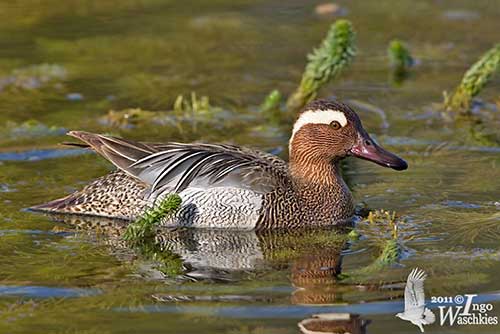
In eclipse plumage, the male resembles female but it is brighter and retains most of the breeding pattern but slightly duller.
The female is duller overall with distinctive striped facial pattern. The bill is paler grey to greenish-grey. The eyes are brown. Legs and feet are olive-grey.
The juvenile resembles female, but it has finely streaked and spotted central underparts.
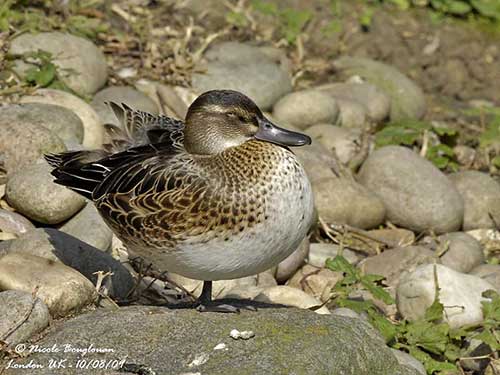
RANGE:
The Garganey breeds in Palearctic, across Eurasia, locally from Britain and France to C Europe, N to S Sweden, and more continuously from E Europe into Russia.
It winters in Sub-Saharan Africa, India and SE Asia, E to New Guinea.
This species is regular migrant in W and C Aleutians and other Alaskan islands.
HABITAT:
The Garganey breeds on shallow ponds, lakes and marshes with abundant emergent, floating and fringing vegetation, on swampy meadows and flooded fields.
During winter, it can be found in lagoons and coastal marshes (fresh and brackish water), also with fringing vegetation. It also frequents ricefields, sewages farms and reservoirs. It can be seen in marine habitats, tidal flats and estuaries, and at sea, close to the shores.
This species breeds between 1200 metres of elevation in Europe and 2600 metres in Ethiopia.
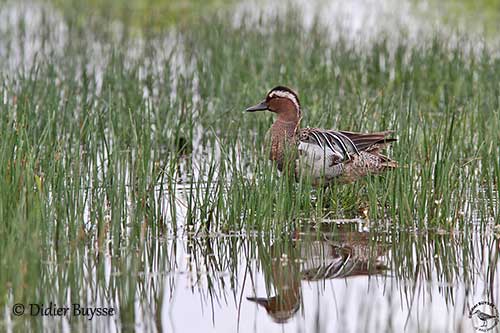
CALLS AND SONGS: SOUNDS BY XENO-CANTO
The Garganey male utters a dry rattling call “knereck” during the displays and when flushed, like a fingernail running along a comb. The female utters a short, high “quack” similar to that of the Eurasian Teal.
BEHAVIOUR IN THE WILD:
The Garganey feeds on various plant seeds, pondweeds and grasses, roots, tubers and green parts of aquatic plants. It also consumes a variety of aquatic invertebrates such as worms, crustaceans, molluscs, insects and their larvae. It takes sometimes small fish and amphibians too. The diet varies depending on season and range.
It forages while swimming, usually with the head under the surface, or by picking from the surface, and dabbling. It may upend in shallow water. It often feeds at night, but also by day in quiet areas.
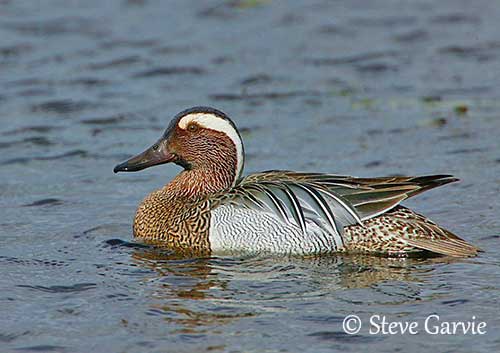
The pairs form mainly on the wintering grounds. Several males often display together and perform some unique displays among dabbling ducks. They lean backwards until the crown touches the lower part of the back, while the bill is pointed upwards. They utter their quick, dry rattle sound before to return to normal posture.
This behaviour enhances the distinctive head pattern of the male, and especially the white curved eyebrow. The copulation occurs probably in water.
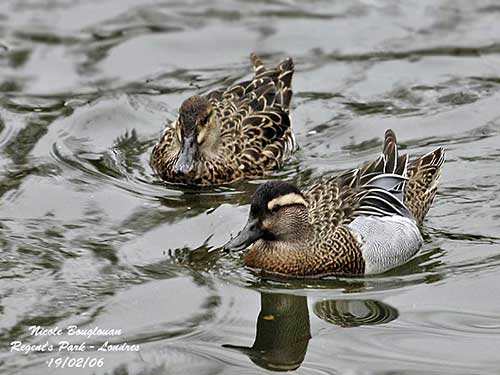
The Garganey is migratory. The autumn migration takes place from late July to October, with first arrivals in Senegal and Niger from early to late September, and peak in W Africa in mid-October.
The return migration from Africa starts in February, but the main passage through Europe is in March-April. They arrive in the northernmost breeding areas in mid-May.
In N India, they arrive between mid and late August, and return to N in late April-mid-May.
The Garganey has fast, direct flight with rapid wingbeats.
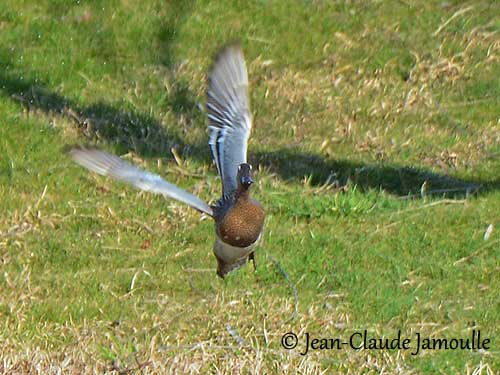
REPRODUCTION OF THIS SPECIES:
The breeding season starts in April-May, with the peak laying in May. The season may vary slightly according to the range.
The Garganey nests solitary or in loose groups, and it is strongly territorial. The female builds the nest on the ground in thick vegetation and often close to water. The nest is a shallow depression lined with leaves, grass and some feathers. This species produces only a single brood per season.
The female lays 8-11 buff to creamy-white eggs at daily intervals. She incubates alone during three weeks (21-23 days), and she is guarded by the male during this period.
At hatching, the chicks have dark brown down above and pale yellow below, with two blackish lines from bill to nape, one through the eye and the other below. They fledge about 35-40 days after hatching, tended only by the female. They are sexually mature at one year old.
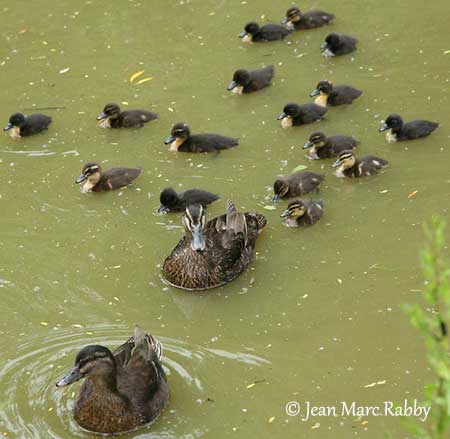
PROTECTION / THREATS / STATUS:
The main nest predator is the American Mink (Mustela vison). The Garganey is threatened by habitat loss through drainage of wetlands and transformation of these habitats, the nests are destroyed by the early mowing of meadows, human disturbance is increasing and the species is hunted in Europe and Africa. It is also threatened by avian influenza both on breeding and wintering grounds.
The global population is estimated to number 2,600,000/2,800,000 individuals (2006). The population trend is decreasing, although this species is still common to abundant throughout the wide range.
The Garganey is currently evaluated as Least Concern.
